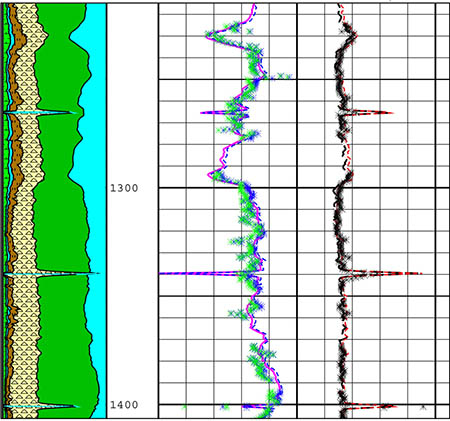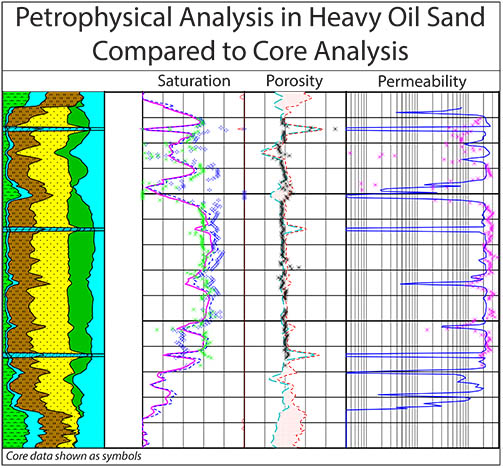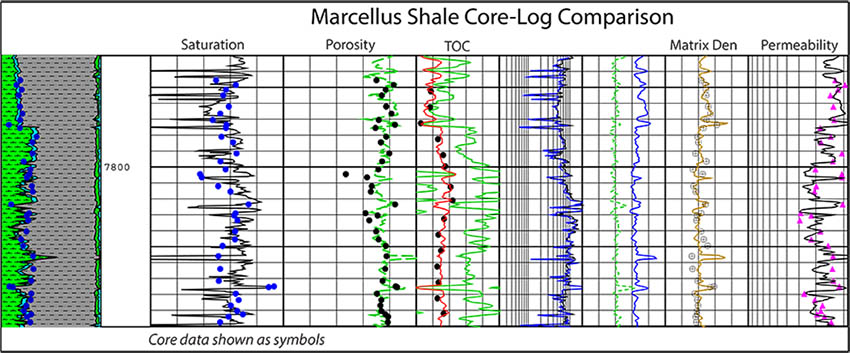
Petrophysics
Not Just Formation Evaluation...
Proprietary petrophysical tools powerful enough to produce the right answers
We have successfully managed projects in North America and worldwide including:
- Field studies and OOIP estimates in fields with 60+ years of production and logs of every type and age
- Shaly freshwater sands
- Thermal and waterflood EOR
- Difficult/unusual logs (old e-logs, nonstandard tools)
- Shales and "unconventional" reservoirs - we are the experts in siliceous shales
- Reservoir properties from fields with primarily old e-logs
- Bypassed pay and identifying ambiguous pay/non-pay on logs
The Marcellus shale section shown below is a very different rock than the heavy oil sand (right), but there is an equally good fit between the core analysis data and the petrophysical results. Since we can routinely achieve this level of accuracy, invalid core or log data is readily identified.
For most reservoir rocks including sands and carbonates, simple petrophysical models give approximately correct answers if the clay content is low. The problems caused by clays were recognized in the 1930's but effective log-based analytical methods to address them were not readily available for several decades. Low- and variable-salinity formation waters, common in California as well as other parts of the world, present their own problems and also can cause the clay effects to be enhanced and more difficult to handle. If the water is very fresh, the clay contribution to the total conductivity can be greater than the formation water contribution. Many researchers addressed these problems in the literature but workflows and analytical software to implement their findings are to this date mostly inadequate.
30 Years of Reservoir Experience
Our shaly sand petrophysical model originated about 30 years ago, and was based on several (at the time) recently-published papers on shaly sands. Although the focus then (and still today) is on the water saturation equation itself, it was clear from the beginning that an accurate water saturation could not be obtained from any of the proposed equations, even those best supported by research, unless the input clay volume, porosity and other parameters were correct. Computer-based log analysis systems were just emerging then, but none of them provided the analytical tools needed for accurate computation of reservoir parameters in California's Tertiary rocks and reservoirs, whose complexities are greater than many software systems can handle even today.
So we began to develop a customized shaly sand model, based on real reservoir problems, logs, and core data. A separate model for diatomite and related rocks was later derived from the shaly sand model. The structure and application of our models developed out of geological and engineering concepts learned from our work as production geologists in the San Joaquin Valley. Both models were calibrated to many excellent core datasets that enabled us to refine, innovate, and enhance our approach to these reservoirs. Eventually we merged the shaly sand and diatomite models so that it was easier to handle the long log sections and field studies which included diatomaceous rocks (all diagenetic phases), clean sands, shaly sands, siltstones, mudstones, shales, and calcareous stringers.
Although much of our work has been focused on the difficulties of clastic reservoirs, we also have an excellent model for carbonates which is based upon extensive work with core data.
These same principles of analysis apply to the "unconventional" shale reservoirs, each of which is different and requires a somewhat unique approach, drawing on elements of clastic, carbonate, and multi-mineral models. As for all of our studies, we use core and other reservoir data to calibrate a unique and customized model for each project and field.
We devote most of our field study time for model calibration to clay volume. When clay is correct, porosity and water saturation are usually easy to calculate using our implementation of the Waxman-Smits and Dual Water models for reservoirs which can be modeled in this way. We have found that this applies to most reservoirs, including clastics, carbonates, and some "unconventional" shales. Some reservoirs do not behave as classic dual-conductor electrical systems, and for those we have developed unique models appropriate to the nature of the rocks. The excellent core-log match shown in the Marcellus Shale example (above) was achieved using a customized analysis designed for the unique characteristics of the rock. Another such project for a particular facies of the Monterey Shale in California is discussed on our Research page. The analytial approach we used for this siliceous shale is based on a model we built to solve a similar problem in Pennsylvania shales, long before the rest of the world discovered these unusual rocks.
Taking It To The World
We have applied our methods and models to reservoirs around the world, with great success. Our flexible and powerful approach to setting up and calibrating petrophysical analysis models is easily adapted to local conditions anywhere.



Why are we different? Our senior professionals have 30+ years of experience in
both
reservoir geology and log analysis, plus wireline operations.
Extensive experience + exceptional knowledge + superior software = Best in Petrophysical Modeling